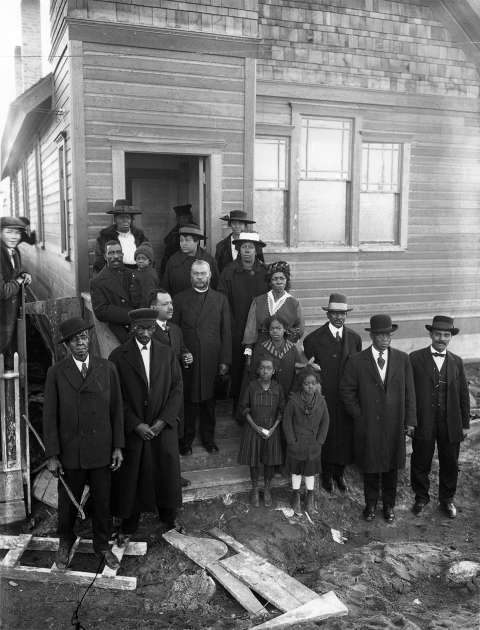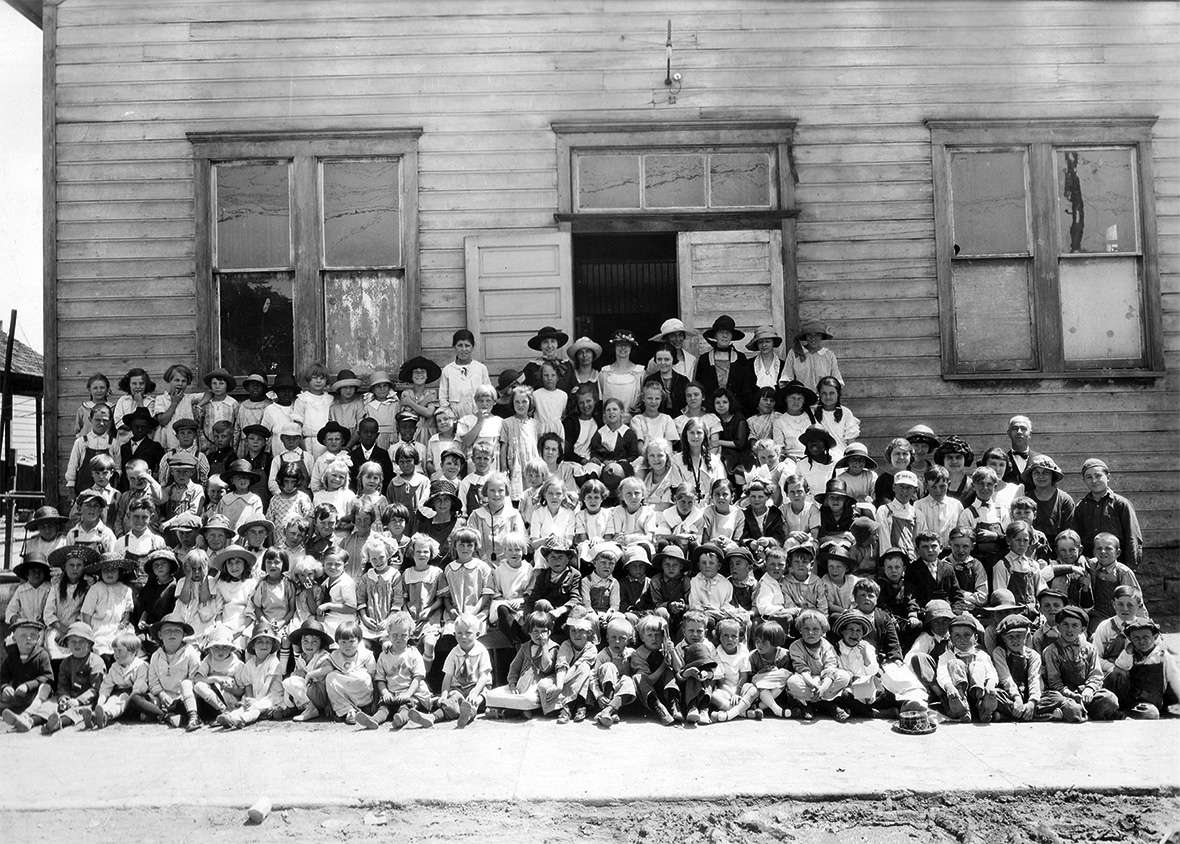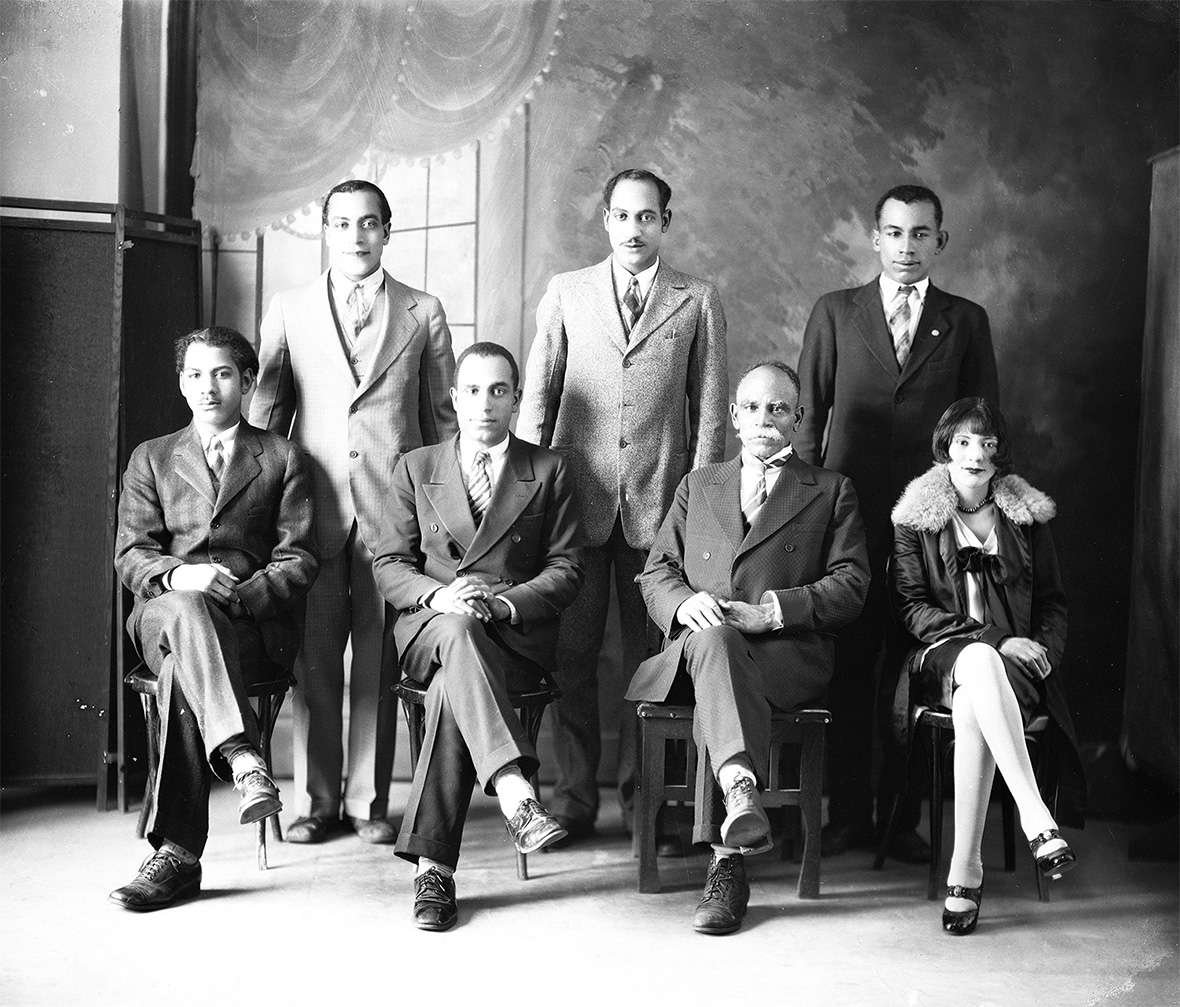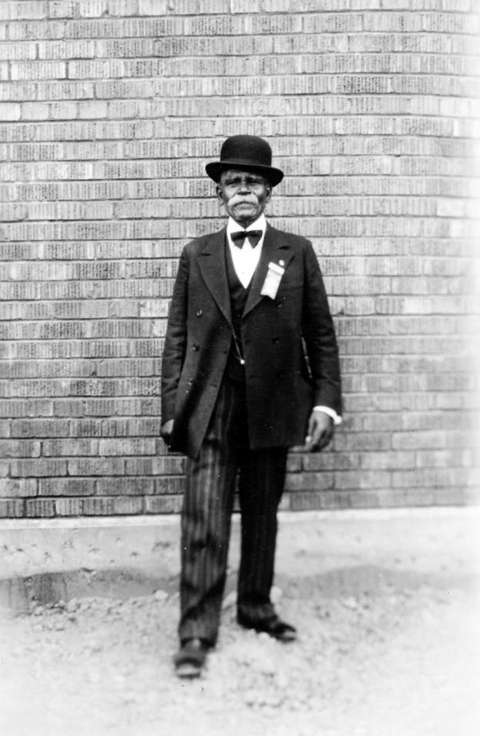- Home
- Encyclopedia
- This Great Struggle: African-American Churches ...
This Great Struggle: African-American Churches in Rock Springs
In the late 19th and early 20th centuries, workers and their families came to southwest Wyoming from around the nation and world, drawn by good wages paid by the coal mines that served the Union Pacific Railroad. The coal-mining town of Rock Springs, Wyo. and nearby railroad town of Green River, along with smaller coal towns like Hanna, Superior and Reliance, became the most ethnically diverse communities in the state.
Many of these people were African-American. In the early 1920s, two congregations came together in Rock Springs to erect a black churche, which became a symbol of the Sweetwater County community they had built.

The first black churches in Wyoming were in Cheyenne, which had a relatively large African-American population from its earliest days. The African Methodist Episcopal (A.M.E.) is the oldest black denomination in the United States, dating back more than 200 years. Cheyenne’s Allen Chapel African Methodist Episcopal, founded either in 1868 or 1878—reports conflict—was the first black church in Wyoming.
In southwestern Wyoming in the early 20th century, towns sprang up wherever the coal reserves looked promising. Several times, coal quality proved to be low and the town disappeared after just a few years.
As a result, it often took several years for townspeople to feel established enough to build permanent church buildings. Several of the towns’ African-American populations were instead served by traveling pastors from Rock Springs or farther afield, despite having strong congregations in towns such as Superior, Wyo. and Dines, Wyo. One exception in the area was Hanna, Wyo., where at least one black church was built in 1924.
In towns like Rock Springs with growing black populations, it became increasingly important to them to have social, professional and religious organizations that demonstrated to black and white communities alike their rightful and respected place in society.
As World War I began, tens of thousands of African-American men from across the nation enlisted in the U.S. Army. Many communities echoed the sentiment found in the poem, “The Negro in Khaki,” printed in a Rock Springs newspaper in 1918:
With every right that is due a man
Must be crowned the black American.
After the war, many returning black soldiers instead were greeted with violence. Lynchings increased and membership surged in the Ku Klux Klan. Wade Hampton was lynched in Rock Springs in 1917 and Edward Woodson was lynched in Green River in 1918. Both were black men.
At this same time appeals began to appear in Sweetwater County newspapers for the black community to “stand for the church and righteousness,” and to “uplift the race to a higher standard” by making financial donations to build a church. The writer of “News of Interest to the Colored People” noted July 26, 1918 in the Rock Springs Rocket:
“Every nationality has a church except us, and we are appealing to the public to help us in this great struggle. … As we realize the church not only helps the community, but it makes labor more stable, makes better citizens, makes homes happier, hence we ask you to help us to plant the banner for Jesus sake. As we are so few, but determined to do all we can to lift up fallen humanity, we ask you to help us.”
The Rev. T.B.J. Barclay and others often wrote these semi-weekly bulletins, not just for African-American readers but also as a way to show the rest of the community their contributions and accomplishments. The bulletins often mentioned prizes and awards won, educational and religious public programs, and news of local soldiers serving in the war.
Nearly every bulletin included an appeal to help build a church. In the early 1920s, two congregations in Rock Springs—the Second Baptist Church of Rock Springs and the Baker’s Chapel African Methodist Episcopal—realized that dream by working together.


J.W. Randolph and the Second Baptist Church of Rock Springs
John Wallace (J.W.) Randolph Sr. arrived in Rock Springs to work in the coal mines in 1899. This puts him in a generation of African-Americans who had been born, most likely into slavery, before or during the Civil War, or born free shortly afterward.
During the Great Migration, which saw thousands of African-Americans leave the South for opportunities in the North or the West, many sought work in the coal mines of West Virginia, Pennsylvania and other eastern locations. Once experienced, they were drawn to the coal mines of Wyoming by the promise of better wages and a better life for themselves and their families.
Randolph was born between 1863 and 1865 in Virginia. It was not uncommon at that time for people born into slavery not to know their own birthdate. Records in Wyoming do not show whether he was born free or not. Some of the early census material does list him as being mulatto, which was defined at the time as someone who had one black parent and one white parent. It suggests that his mother was a slave.
He would have been around 35 years old when he arrived in Rock Springs in 1899, with wife Mary and son John Jr. in tow. The Randolphs went on to have six more children and settle into a comfortable and influential life in Rock Springs.

The “Randolph Boys” were well-known around town and in photographs appear dapper and outgoing. J.W., who always appears more stoic than his sons, had a reputation as hardworking, helpful and community-minded. He retired from the Union Pacific Coal Company in 1929 after 30 years of service and was honored as an “Old-Timer” in 1942. During that time, he was a prominent local figure in the United Mine Workers of America and served on delegations to union conventions several times.
He was also active in several local organizations designed build up the black community, including the Roosevelt Republican Club. Prominent African-Americans were often involved with the Republican Party—the party of Lincoln—prior to the 1960s. But what he was best known and loved for was his role as pastor of the Second Baptist Church of Rock Springs.
J.W. Randolph was one of the main people actively seeking funds to build a church specifically for the African-American community in Rock Springs prior to 1920. He was also getting his feet wet preaching at various events and doing baptisms and funerals with other pastors who came at times to help found the Rock Springs church. His wife, Mary, was also very active in church activities until her untimely death in 1924.
The black Baptist congregation met most often at the Finnish Lutheran Church—generally called the Finnish Church—on M Street before raising enough funds for their own building, early plans for which said it was to be on Rainbow Avenue, now Pilot Butte and Paulson avenues.
Although the congregation had already chosen him as pastor in September 1920, J.W. Randolph was officially ordained into the Gospel Ministry by unanimous vote of the ordaining council and about 50 members of the Second Baptist congregation Jan. 16, 1921. Just 10 days later on Jan. 26, 1921, the Second Baptist Church of Rock Springs, Wyo., incorporated in the office of the Secretary of State with J.W. Randolph as the agent in charge.
J.W. Randolph passed away at the Wyoming General Hospital in Rock Springs in November 1943, though he had gone to live with his adult children on and off in California during the 1930s. Randolph Street in Rock Springs, just north from what used to be Rainbow Avenue, is named for him.
The African Methodist Episcopal Church of Rock Springs
Although the African Methodist Episcopal (A.M.E.) Church of Rock Springs had a longer history than the Second Baptist, less is known of its origins. St. John’s, founded around 1904 under the Rev. James G. Cole and again in 1913, was the first A.M.E. church in Rock Springs. It is unclear how long these congregations lasted.
The third iteration of the A.M.E. had a story similar to the Second Baptist, with its congregation meeting in the Finnish church and various other locales while they raised funds for a building of their own.
The Rock Springs Rocket reported a “new” A.M.E. church was organized in Rock Springs on Oct. 27, 1917, by the Rev. T.B.J. Barclay, sent by the Colorado Annual Conference of the A.M.E. Church.
Although the A.M.E. church of Rock Springs is identified in city directories, on maps and in the newspaper as “Baker’s Chapel,” it is unclear which Baker it is named for and just who was the rallying figure behind its formation.
First, the newspaper names a Rev. C.N. Baker and a Rev. L.W. Baker in 1922 as being the inspiration for the chapel’s name. As no one by these initials shows up in other records for the area, it is possible they were visiting pastors, many of whom came from other parishes throughout the years to help establish the church.
One pastor undoubtedly involved was Warren L.N. Baker. Little is known about him, his wife Mary, or their children. From records that do exist it does seem he spent his career traveling to various towns throughout Montana and Wyoming helping to establish A.M.E. churches. He was pastor in Great Falls, Mont., from 1901 to 1906, helping a congregation build a church in 1902. In 1908, he was in Helena, Mont. He then moved on to Cheyenne around 1910 and was in Thermopolis in 1920.
At the rally where the cornerstone of the Rock Springs church was laid in 1921, the Rev. W.L.N. Baker was appointed to the circuit of Rock Springs and Rawlins by A.M.E Bishop H.B. Parks. It’s possible that Baker died in Cheyenne since both his wife and his son are buried there, but without a headstone. Most likely, he is the Baker of Baker’s Chapel.
The Church Building
Beginning about the same time as the Second Baptist, the A.M.E. congregation began soliciting donations to build a church. Both congregations had been meeting at Finn Hall and both congregations had similar goals for social uplift and securing a more prominent place in Rock Springs for black citizens. By joining together, they were able to successfully fundraise enough to erect a building through rallies and donations. Although city directories, land records, and maps only identify the property as belonging to the A.M.E. Church, it appears both congregations met in this building into the 1950s. Some residents today still have a distant recollections of the Second Baptists meeting there.
The cornerstone of the joint Rock Springs A.M.E.-Second Baptist church was laid April 3, 1921 at the corner of N and Channel streets, just off of Rainbow Avenue. By April of the following year, the newspaper reported that “perhaps the most enthusiastic and positive religious campaign ever conducted in this city by the colored people is now under way at the A.M.E. church.”
The building was planned and built by an African-American carpenter named Tustin Brawley. His World War I registration card lists him as a resident of New Mexico and there is no record of his having lived in Wyoming, so the congregation may have recruited him to come to Rock Springs to build their church.
The building has now been remodeled and has a 1970s stone façade. It stands on an odd, v-shaped corner in what was in the 1920s an expanding neighborhood. The Union Pacific Coal Company offices, the Old Timers Club, the Excelsior Garage and the Eastern Orthodox (Greek) church were all just on the next block. In the surrounding neighborhood, then known as East Flat, families of various ethnic and national origins, including African-Americans, were buying their first homes after years of living in company housing.
In March 1922, the church announced a week-long revival to celebrate its upcoming one-year anniversary. The program would feature Madame Ida B. Jefferson, evangelist, of an A.M.E. church in Texas who was said to possess the power to heal and was renowned for her preaching. The Rocket declared March 10 that “God has given her the power to heal and lead the people from darkness to light. Her advice on business problems is worth more than you will ever be able to pay. Madame Jefferson can bring tangled brains to the light of helpful sensibility. She can cure any disease that you were not born with.” The week ended with an evening sermon from Madame Jefferson. The public was invited to attend.

In January 1935, the Baker’s Chapel, which had been without a pastor for several years, welcomed the Rev. H.H. Hooks, previously of Casper and Cheyenne, as the new pastor. The church continued to operate until about 1954, the last time it is listed in the city directories, and the land was sold a few years later.
Changing Times
African-American populations in Sweetwater County dwindled mid-century as people began to leave for larger metro areas. Most coal-mining jobs disappeared after the Union Pacific in the early 1950s began fueling its locomotives with diesel. Many of the smaller coal towns began to shut down.
This may be the reason the Second Baptist-Baker’s Chapel A.M.E. closed its doors. In the 1970s, when the boom-and-bust towns of southwest Wyoming boomed again, several other congregations emerged. In 1981, the People’s Missionary Baptist Church formed because “the black community here was in need of a church,” according to the pastor who traveled from Casper to help set it up. Today, The New Hope Baptist Church and several other denominations serve the African-American community in Sweetwater County.
Resources
Primary Sources
- “A.M.E. Church,” Sheridan Enterprise, August 3, 1912, 5.
- “A.M.E. Church Cornerstone to be Laid April 3rd,” Rock Springs Rocket, March 18, 1921, 1.
- “Anniversary A.M.E. Church,” Rock Springs Rocket, March 10, 1922, 3.
- “Black Baptist Church Chartered,” Rock Springs Rocket-Miner, August 22, 1981, 1.
- “Colored Baptists Organize,” Rock Springs Rocket, September 3, 1920, 1.
- “Colored People News,” Rock Springs Rocket, August 14, 1918, 2.
- “Colored People News,” Rock Springs Miner, August 16, 1918, 2.
- “Death of Wife of Rev. J.W. Randolph,” Rock Springs Rocket, May 16, 1924, 2.
- “Old Timer Passes,” The Union Pacific Coal Company Employes’ Magazine, Vol. 20 No. 12 (December 1943): 516.
- “First Baptist Church,” Rock Springs Rocket, January 21, 1921, 7.
- “New A.M.E. Church,” Rock Springs Miner, November 9, 1917, 6.
- “New Pastor for A.M.E. Church,” The Union Pacific Coal Company Employes’ Magazine, Vol. 12 No. 1 (January 1935): 25.
- “New Year’s at Second Baptist Church,” Rock Springs Rocket, January 6, 1922, 1.
- “News of Interest to the Colored People,” Rock Springs Rocket, July 26, 1918, 4.
- “News of the Colored People,” Rock Springs Rocket, March 1, 1918, 4.
- “News Pertaining to the Colored People,” Rock Springs Rocket, August 2, 1918, 4.
- “Notice of Incorporation,” Rock Springs Rocket, March 18, 1921, 7.
- Polk’s City Directory: Rock Springs and Sweetwater County. Omaha: R.L. Polk & Co. 1931-1954.
- “Randolph Funeral Rites Wednesday,” Rock Springs Rocket, November 9, 1943, 5.
- “Religious Campaign Under Way at A.M.E. Church,” Rock Springs Rocket, April 7, 1922, 1.
- “Rosevelt [sic] Republican Club Organized,” Rock Springs Rocket, April 15, 1910, 1.
- Sanborn Fire Insurance Maps. Rock Springs, Wyo. (1920, 1931, 1946).
- “Second Baptist Church,” Rock Springs Rocket, March 11, 1921, 8.
- “St. John’s A.M.E. Chapel,” Rock Springs Independent, June 3, 1905, 2
- Twelfth Census of the United States, 1900; Fifteenth Census of the United States, 1930. Fourteenth Census of the United States, 1920. Sixteenth Census of the United States, 1940. Thirteenth Census of the United States, 1910. National Archives, Washington, D.C.
- “The New Forty-Year Class,” The Union Pacific Coal Company Employes’ Magazine, Vol. 19 No. 7 (July 1942): 269.
- Warranty Deed, Book Q, Page 169. First Baptist Church of Rock Springs, June 17, 1911. Sweetwater County Courthouse, Green River, Wyo.
- Warranty Deed, Book 291, Page 462-6. African Methodist Episcopal Church in the United States to Lloyd Jackson, January 12, 1962. Sweetwater County Courthouse, Green River, Wyo.
- World War I Selective Service System Draft Registration Cards, 1917-1918. New Mexico; Registration County: Bernalillo; Roll: 1711857. Washington, D.C.: National Archives and Records Administration. M1509, 4,582 rolls. Imaged from Family History Library microfilm.
Secondary Sources
- Case, Samantha. “Allen Chapel, Cheyenne.” Alliance for Historic Wyoming. August 2016. Accessed Jan. 21, 2017 at https://www.historicwyoming.org/historicplacesblog/allen-chapel.
- Dickerson, Dennis C. “African Methodist Episcopal Church: Our History.” Accessed Jan, 21, 2017 at https://www.ame-church.com/our-church/our-history/.
- Hallberg, Carl V. An Introduction to Wyoming’s Ethnic Churches, Wyoming State Historical Society, 2002, 5-9.
- Krugler, David F. 1919, The Year of Racial Violence: How African Americans Fought Back. New York: Cambridge University Press, 2015.
- Robison, Ken. “Historical Black Americans in Northern Montana: Early Black American Settlers Great Falls MT 1886-1920,” Overholster Historical Research Center. Accessed Jan. 21, 2017 at http://www.blackamericansmt.blogspot.com/2009/05/early-black-american-settlers-great.html.
Illustrations
- All the black and white photos are from the collections of the Sweetwater County Historical Museum. Used with permission and thanks.
- The photo of the students at the Finnish Church is negative 73-81-20. The 1922 photo of the parishoners of the joint Second Baptist-A.M.E. Church is New Studio Collection negative 458. It has been identified in other publications as being a picture of parishioners of the A.M.E. Church of Rock Springs. The photo of J.W. Randolph and his family is negative 1281 from the New Studio Collection. The photo of Randolph wearing his Old-Timer Badge is from the Union Pacific Coal Co. Collection.
- The color photo of the A.M.E. Church in Rock Springs is by the author. Used with permission and thanks.
